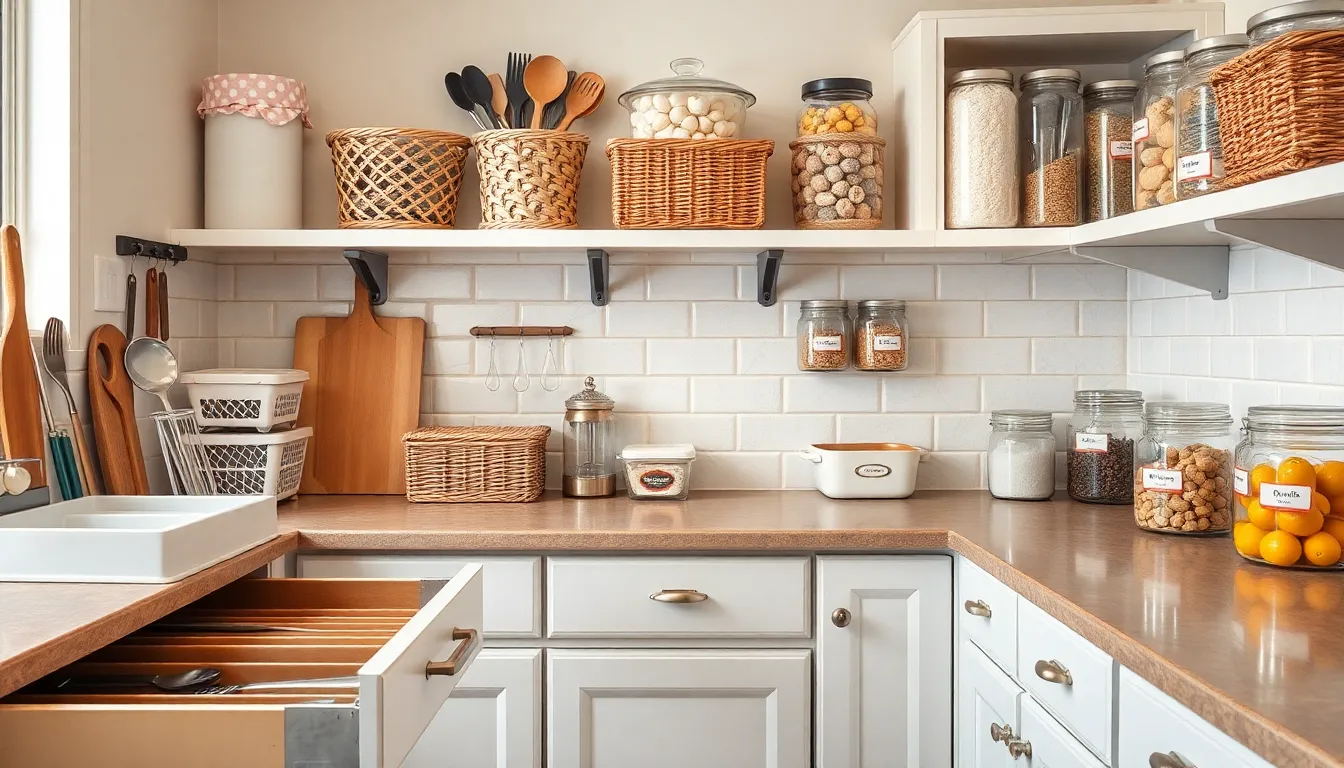A cluttered kitchen can feel like a culinary battlefield where pots and pans wage war against the spices and utensils. If the thought of finding that elusive can opener makes you want to throw in the towel, it’s time for a kitchen makeover. DIY kitchen organization isn’t just about tidying up; it’s about transforming chaos into a culinary oasis where creativity flourishes.
Table of Contents
ToggleBenefits of DIY Kitchen Organization
DIY kitchen organization offers numerous advantages that enhance both functionality and visual appeal. Transforming a cluttered kitchen into a well-organized space boosts productivity and creativity while cooking.
Improved Efficiency
Improved efficiency stems from a systematic arrangement of kitchen tools and ingredients. An organized pantry allows quick access to essential items, reducing meal preparation time. Clear storage solutions enable easy visibility of supplies, minimizing unnecessary purchases. Labeling containers further speeds up cooking processes, ensuring ingredients are readily available. Additionally, dedicating specific zones for appliances and utensils streamlines workflow, allowing for seamless transitions between cooking tasks.
Enhanced Aesthetics
Enhanced aesthetics emerge from a rearranged kitchen that showcases intentional design choices. An organized kitchen creates a sense of harmony, making it more inviting for family and guests. Utilizing matching storage bins can unify the look of countertops, contributing to a cohesive theme. Incorporating decorative elements, such as plants or art, personalizes the space while maintaining functionality. A visually appealing kitchen can inspire creativity, turning cooking into a joyful experience rather than a chore.
Essential Tools and Materials

Creating an organized kitchen requires various tools and materials that streamline storage and enhance functionality. Choosing the right items makes a significant difference.
Organizers and Storage Solutions
Drawer dividers help separate utensils, ensuring easy access to each item. Shelf risers maximize vertical space, allowing for better visibility of pots, pans, and dishes. Baskets or bins offer flexible storage options, accommodating a variety of kitchen goods. Additionally, using clear containers not only organizes dry goods but also simplifies inventory checks. Magnetic strips can hold knives or metal utensils, clearing counter space. They provide a unique solution for smaller kitchens.
Labels and Markers
Labeling enhances organization in any kitchen. Using label makers ensures a professional finish, while handwritten labels add a personal touch. Clear adhesive labels allow visibility of contents without opening containers. Colored markers can distinguish between various food groups, making it easier to identify ingredients. Consider using chalkboard labels for a fun, reusable option. Labeling not only saves time during meal prep but also helps maintain order.
Steps for Effective DIY Kitchen Organization
Transforming a cluttered kitchen into an organized space involves several key steps that enhance functionality and style.
Decluttering Your Kitchen
Begin by removing all items from your kitchen. Assess each object and eliminate duplicates, broken tools, or items not used in the last year. This process clears visual and physical space, making organization easier. Create designated zones for keepers, tossers, and donors, simplifying decision-making. Once these categories are established, dispose of or donate items responsibly. Finishing this step creates a blank canvas for further organization.
Categorizing Items
After decluttering, focus on categorization. Group similar items together for efficient access. Consider categories like baking supplies, cooking utensils, and pantry staples, ensuring each group has a designated spot. Use drawer dividers and shelf risers to maximize vertical space and keep groups contained. Transparent bins help identify contents at a glance, promoting easy retrieval. Label each bin or container to reduce confusion and speed up meal prep. This structured approach not only organizes but also enhances the kitchen’s visual appeal.
DIY Organization Projects
Transforming a cluttered kitchen into a well-organized space requires practical and manageable projects. Consider implementing straightforward solutions to enhance functionality and flow in the kitchen.
Drawer Dividers
Drawer dividers create sections within drawers for utensils, tools, and gadgets. They allow for easy access and prevent drawers from turning into chaotic junk piles. Various sizes and materials exist, catering to specific drawer dimensions and personal styles. For optimal organization, measure the drawer space beforehand and choose dividers that fit snugly. Adjustable dividers also provide flexibility, adapting to the varying heights of utensils or tools.
Pantry Storage Ideas
Pantry organization significantly impacts kitchen efficiency. Clear containers can store grains, pasta, and snacks while keeping items visible. Labeled bins provide a straightforward way to categorize similar products, simplifying access during meal prep. Using stackable storage solutions maximizes vertical space and keeps the pantry looking tidy. Installing pull-out shelves makes reaching back items easier, promoting better utilization of deep pantries. Adding a lazy Susan can enhance access to condiments or spices, ensuring everything stays within reach.
Vertical Space Utilization
Maximizing vertical space transforms cramped kitchens into functional areas. Wall-mounted shelves can hold spices, cookbooks, or decorative items. Hanging pots and pans on ceiling racks frees up cabinet space while creating an eye-catching display. Use pegboards for versatile storage options, providing hooks to hang utensils and cooking tools. Magnetic strips can also be mounted on walls for knives and metal utensils, keeping countertops clear. Overall, utilizing vertical space promotes an organized and efficient kitchen setup.
Maintaining Your Organized Kitchen
Keeping an organized kitchen requires ongoing effort and attention. Consistent maintenance habits ensure efficiency remains high while clutter stays low.
Regular Decluttering
Regular decluttering serves as an essential practice for maintaining an organized kitchen. It involves a thorough review of kitchen items every few months. Set aside time to evaluate utensils, pots, and pantry ingredients. Identifying duplicates or expired items reduces chaos and increases efficiency. Removing unnecessary items helps to refresh the workspace. Keeping counters clear encourages a functional cooking environment. Incorporating this routine will lead to long-lasting organization.
Seasonal Organization Tips
Seasonal organization offers a chance to adapt kitchen setups. Each season presents unique cooking needs and ingredients. For summer, prioritize grilling tools and fresh produce storage solutions. Organize holiday baking supplies during the fall for easy access. Use these transitions to assess often-overlooked areas. Reviewing spaces like cabinets or food storage can reveal forgotten equipment. Adjusting arrangements seasonally helps to maintain order and accessibility, reinforcing an efficient kitchen setup.
Transforming a cluttered kitchen into an organized haven is achievable through DIY efforts. By implementing simple strategies and utilizing effective tools, anyone can enhance both functionality and aesthetics. The journey begins with decluttering and categorizing items, making it easier to create a system that works.
Regular maintenance is key to sustaining this newfound order. Embracing seasonal adjustments not only keeps the kitchen efficient but also aligns with changing culinary needs. With a little creativity and commitment, an organized kitchen can inspire culinary adventures and make meal preparation a breeze.





